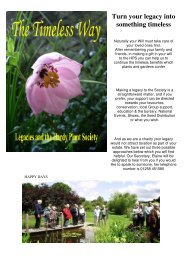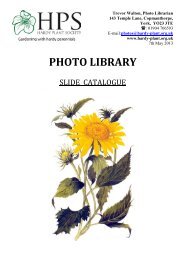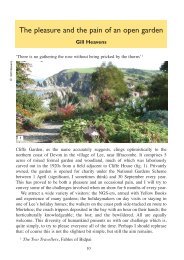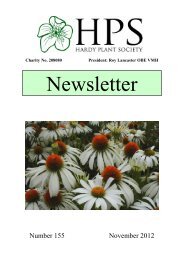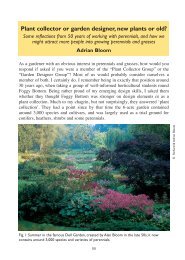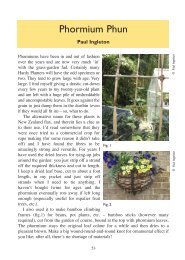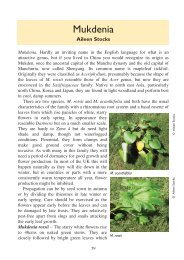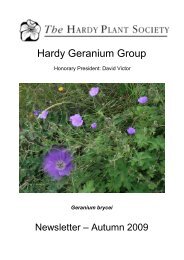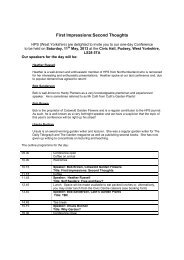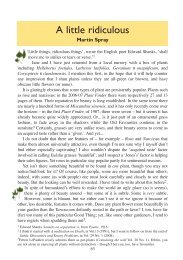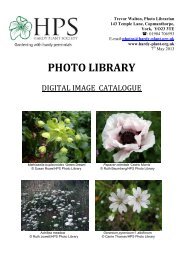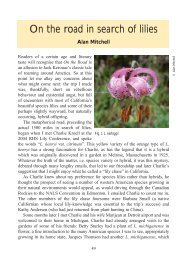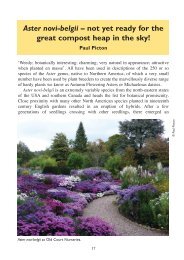(Peat free) Growing Media - Hardy Plant Society
(Peat free) Growing Media - Hardy Plant Society
(Peat free) Growing Media - Hardy Plant Society
You also want an ePaper? Increase the reach of your titles
YUMPU automatically turns print PDFs into web optimized ePapers that Google loves.
Garden<br />
The<br />
<strong>Growing</strong> media 2010–2012
gardenscience<br />
arguments<br />
for going<br />
<strong>Peat</strong>-<strong>free</strong><br />
l Many peat-<strong>free</strong> or peatreduced<br />
growing media prove<br />
suitable for a range of<br />
purposes, such as rooting<br />
cuttings (top) or potting-on.<br />
l Reducing the amount of<br />
peat gardeners consume will<br />
help ensure the protection<br />
of lowland raised peat bogs<br />
(above), which are rare habitats<br />
in the UK, home to plants such<br />
as sundews and many mosses<br />
and sedges.<br />
l As a result, peat bogs can<br />
continue to act as valuable<br />
carbon sinks, storing carbon<br />
in a form that does not<br />
negatively contribute to<br />
climate change.<br />
l <strong>Peat</strong>lands also play a role in<br />
the global water cycle – their<br />
destruction may lead to<br />
increased risk of flooding.<br />
Time for an<br />
alternative<br />
When choosing<br />
multipurpose<br />
compost (left)<br />
it is possible to<br />
find peat-<strong>free</strong><br />
formulas, such<br />
as those based<br />
on coir, or peatreduced<br />
mixes<br />
peat?<br />
What<br />
future<br />
for<br />
Andrea Jones<br />
Gardeners have been using peat-based<br />
composts since the 1970s, but environmental<br />
concerns makes future use uncertain. Susie<br />
Holmes provides an update on the issue.<br />
Photography by Tim Sandall<br />
<strong>Peat</strong>-based composts are, for a<br />
generation of gardeners, synonymous<br />
with gardening. Almost all the plants<br />
we buy are grown in them and they<br />
constitute the vast majority of composts<br />
sold – in fact home gardeners account<br />
for about 70 percent of all UK peat use.<br />
Our love affair with peat-based<br />
compost began in the 1970s when peat<br />
took over from loam-based John Innes<br />
mixes, transforming the horticultural<br />
industry in the process. Until recently<br />
most ‘multipurpose compost’ and<br />
growing bags were 100 percent peat,<br />
with lime and fertiliser added, although<br />
many products now contain at least<br />
10–20 percent other materials as<br />
manufacturers (encouraged by the UK<br />
Government) try to reduce peat use.<br />
<strong>Peat</strong> and the environment<br />
So why can we not carry on using peat<br />
to grow plants? There are two major<br />
concerns over peat extraction.<br />
The loss of biodiversity from rare lowland<br />
peat habitats has historically been<br />
the main problem, and Government<br />
targets for peat extraction are part of<br />
the UK Biodiversity Action Plan,<br />
developed as a response to the 1992<br />
Convention on Biological Diversity,<br />
encouraging sustainable development.<br />
The second and more recent concern<br />
is the loss of peat as an important store<br />
of carbon, once bogs are drained and<br />
peat extracted. This peat, over time,<br />
gradually breaks down, giving off CO 2<br />
,<br />
a greenhouse gas. As a result, new<br />
Government targets for peat replacement<br />
will be linked to the ‘Act on CO 2<br />
’<br />
campaign (see News, p147). As such a<br />
large proportion of horticultural peat is<br />
used by home gardeners, there is<br />
pressure on the gardening public to do<br />
their bit, in addition to efforts by the<br />
professional sector.<br />
Although a UK Government target<br />
set some years ago to make 90 percent<br />
of composts peat-<strong>free</strong> by 2010 will not<br />
be met, limited progress has been made<br />
– a reduction of around 25 percent has<br />
so far been achieved.<br />
Arguments that far more peat is<br />
burned in power stations globally than<br />
used in horticulture are unlikely to make<br />
any difference, either – in the battle to<br />
reduce greenhouse gas emissions,<br />
every bit saved helps. P<br />
178 March 2010 March 2010 179
Gardenscience<br />
<strong>Growing</strong> media options<br />
British gardeners often use the word<br />
‘compost’ when they actually mean<br />
‘growing medium’; technically ‘compost’<br />
is the product of a composting process,<br />
which in most cases growing media are<br />
not, so this often causes confusion.<br />
We should not assume replacing all<br />
or some peat in a mix is bad. Blending<br />
in materials such as bark and wood fibre<br />
can improve drainage, while green<br />
compost or loam improves water and<br />
nutrient holding, creating mixes which<br />
are actually better for growing in than<br />
pure peat. However, there is no mix ideal<br />
for every situation, and gardeners will<br />
find some blends are better for certain<br />
uses; a coir-based mix is good for seed<br />
sowing and propagation, for example,<br />
but a blend with bark or wood fibre<br />
will probably suit outdoor planters.<br />
There is nothing new about this, in<br />
essence – gardeners have long blended<br />
their own media for specific uses, but<br />
the materials manufacturers are adding<br />
to shop-bought media may be in some<br />
cases unfamiliar. Moreover, it is not<br />
always easy to ascertain the precise<br />
ingredients in a bag of ‘compost’.<br />
Manufacturers, however, are now improving<br />
labelling so it should soon be<br />
easier to see what the peat content is<br />
<strong>Peat</strong>-<strong>free</strong> media can be<br />
used for many purposes,<br />
including topdressing for<br />
plants in containers<br />
‘different blends<br />
suit different<br />
people, depending<br />
on the types of<br />
plant you grow<br />
and how you water<br />
and feed them’<br />
– and which other materials are used in<br />
the mix. Some are even adopting a barchart<br />
system, in much the same way<br />
packaging of certain foods shows the fat<br />
and salt content. The Government is also<br />
encouraging more in-store information<br />
to make it easier for gardeners to make<br />
‘greener’ growing media choices.<br />
The main source of independent<br />
information on different brands of<br />
growing media is the annual Gardening<br />
Which? test report but, as with any peatbased<br />
mix, different blends suit<br />
different people, depending on the<br />
types of plants you grow and how you<br />
water and feed them – do not be put off<br />
if the first alternative mix you try does<br />
not suit you.<br />
Adapting to new media<br />
Often, the biggest problem gardeners<br />
have when changing to a new growing<br />
medium is with watering. Some reducedpeat<br />
or peat-<strong>free</strong> media dry quickly on<br />
the surface yet are still moist below,<br />
making it all too easy to overwater plants.<br />
However, an advantage of this drier<br />
surface is reduced moss and liverwort<br />
growth compared to peat mixes. It may<br />
also be necessary to feed plants differently<br />
in reduced-peat or peat-<strong>free</strong> media.<br />
Coir-based mixes may need feeding<br />
earlier and mixes containing green<br />
compost may last longer without feeding<br />
because of the slow-release nutrients<br />
that the compost supplies.<br />
The materials outlined opposite (p181)<br />
are alternatives used by manu fac turers<br />
in peat-reduced, and even peat-<strong>free</strong>,<br />
growing media likely to be found at<br />
garden centres. These four alternatives<br />
are considered to have a significantly<br />
reduced impact on the earth’s climate<br />
system in comparison with peat.<br />
Other materials<br />
Mineral-derived materials such as perlite<br />
and rockwool can be used in growing<br />
media, but either need to be added at a<br />
low percentage (because of their low<br />
water-holding capacity) or used in<br />
hydroponic systems. High energy is<br />
needed for their manufacture; they do<br />
not degrade after use.<br />
Loam is used at a low percentage in<br />
some mixes to improve water and<br />
nutrient retention, for example in John<br />
Innes products. However, good quality<br />
loam is scarce and not renewable.<br />
No one material can replace peat, but<br />
the quality of alternatives has improved<br />
hugely and as a result the RHS is committed<br />
to helping gardeners reduce<br />
peat use. If you are not confident, try a<br />
reduced-peat mix first, especially for<br />
specialist plants. For tubs of shrubs or<br />
summer bedding, quality peat-<strong>free</strong><br />
media should perform well.<br />
The key to success with new growing<br />
media is managing watering and nutrition,<br />
and not expecting them to behave<br />
like peat. The Government will continue<br />
to encourage gardeners to use less peat,<br />
which should mean a wider choice of<br />
reduced-peat and peat-<strong>free</strong> products,<br />
with better information on packs and in<br />
store. Our reliance on peat is fairly recent<br />
– gardeners have adapted to changes<br />
before, and so can again. n<br />
Susie Holmes is an independent<br />
growing-media consultant who<br />
specialises in peat alternatives<br />
@<br />
i<br />
For more information, visit:<br />
www.rhs.org.uk/peat<br />
This year, a project at RHS Garden<br />
Wisley will review how to water, and<br />
manage nutrients in, peat-<strong>free</strong> products.<br />
l Further reading The March issue<br />
of The <strong>Plant</strong>sman, quarterly sister<br />
publication to The Garden, includes a<br />
more detailed review of peat alternatives.<br />
For subscription details, tel: 0845 062 1111<br />
or visit: www.rhs.org.uk/plantsman<br />
susie holmes<br />
Does what it says? The labelling on<br />
growing-media bags is beginning to<br />
improve. Some products found in garden<br />
centres and nurseries clearly state if a<br />
product is peat-<strong>free</strong> (above); other<br />
reduced-peat mixes may need closer<br />
examination (below right and bottom).<br />
<strong>Peat</strong>-substitute materials include bark<br />
(above right), which is usually added to<br />
peat mixes and broken up into small<br />
particles before use. Wood fibre (right) is<br />
a relatively recent material, added to<br />
compost mixes by some manufacturers.<br />
Coir (below) and composted green waste<br />
(bottom right) are better known, and have<br />
been used in home-made mixes<br />
Coir<br />
Wood fibre<br />
Bark<br />
Green compost<br />
paul alexander / rhs<br />
growing <strong>Media</strong><br />
components<br />
l Bark<br />
A by-product of the timber industry,<br />
bark can be considered a sustainable<br />
resource because forestry plantations<br />
are replaced in a cycle of harvesting<br />
and replanting. Pine or spruce barks<br />
generally are the main types used;<br />
bark of deciduous trees is often toxic<br />
to plants. Bark is useful in mixes for<br />
plants that are outdoors over winter<br />
and for species that need good<br />
drainage, but usually must be blended<br />
with more water-retentive materials.<br />
l Wood fibre<br />
Manufactured wood fibre is a recent<br />
addition to the peat-alternatives range<br />
in the UK. It is produced by subjecting<br />
wood chips to pressure, which expands<br />
them to a fluffy fibre. Wood fibre has<br />
the advantage of being a consistent<br />
material from a renewable resource<br />
and various products now contain it.<br />
l Coir<br />
Coir pith dust is a by-product of coirfibre<br />
production in countries such as<br />
India and Sri Lanka. Fibre from coconut<br />
husks is used in ropes, mattresses and<br />
matting, but the dust is a waste product<br />
that was once burned or accumulated<br />
in heaps. Coir has been used in growing<br />
media since Victorian times and is<br />
closer to peat in terms of its air-towater-capacity<br />
ratio than other<br />
alternatives. Coir is imported in a<br />
compressed state and reconstituted in<br />
the UK, making transportation cheaper:<br />
coir’s ‘carbon footprint’ is not too bad<br />
as it is transported mostly by ship.<br />
Coir can be used in reduced-peat<br />
blends and even undiluted: it has good<br />
air capacity as it holds air within the<br />
‘honeycomb’ structure of its particles.<br />
Its texture promotes root growth so is<br />
suitable for seed mixes and cuttings,<br />
and for potting indoor plants.<br />
l ‘Green compost’<br />
This is the term for compost from green<br />
waste materials, such as brushwood,<br />
grass clippings and tree prunings,<br />
made at large composting facilities.<br />
Green compost is already used at a low<br />
percentage (typically 10–20 percent)<br />
in many multipurpose products and<br />
growing bags. It behaves like loam,<br />
holding nutrients and water well,<br />
making it useful for summer planters<br />
and hanging baskets.<br />
180 March 2010<br />
March 2010 181
GARDenPRACTICe<br />
Getting<br />
to grips with<br />
peat-<strong>free</strong><br />
A range of peat-<strong>free</strong> media has<br />
been available for years, yet<br />
gardeners are still confused<br />
which to choose and how<br />
best to manage them. rhs<br />
experts Paul Alexander and<br />
Nick Morgan offer practical<br />
examples to help guide us.<br />
Photography by tim sandall<br />
January 2011 51
gardenpractice<br />
As the need to reduce the use of peat<br />
becomes more pressing, home gardeners<br />
can face a daunting choice of alternatives<br />
(see The Garden, March 2010, pp178–181).<br />
These numerous products make a variety of<br />
claims regarding their use, and the selection<br />
of growing media on offer is further<br />
complicated by the presence of peat-based,<br />
peat-reduced and peat-<strong>free</strong> products.<br />
The RHS promotes sustainable use of<br />
peat alternatives and will support progress<br />
towards the Government’s target of a total<br />
withdrawal of peat use by home gardeners<br />
by 2020. Whatever your own thoughts on<br />
peat use in horticulture, there is a need for<br />
gardeners and growers to understand how<br />
to manage peat-<strong>free</strong> growing media.<br />
Consider these key points<br />
when choosing a compost:<br />
l What is it to be used for? Multipurpose<br />
compost (peat-based or peat-<strong>free</strong>) is suited<br />
for potting and growing on (see below) as<br />
well as raising seed; more specialist seed<br />
and cutting composts (see pp54–56) may<br />
provide better results.<br />
l How easy is it to wet the growing<br />
For many gardeners, changing to<br />
peat-<strong>free</strong> media can prove testing.<br />
RHS scientist Paul Alexander (left)<br />
outlines the issues of finding an<br />
acceptable peat replacement, and<br />
makes suggestions for a smooth<br />
transition, based on his research<br />
medium properly and how well does it<br />
then hold onto water?<br />
l Are nutrient levels available in the<br />
medium suitable for the plants you wish<br />
it to support?<br />
<strong>Media</strong> components<br />
Most growing media (including peat-based)<br />
are blends of one, or possibly two, main<br />
ingredients with a small volume of a variety<br />
of other materials for specific beneficial<br />
properties. The principal materials tend to<br />
dominate how growing media perform<br />
although this can be unpredictable due<br />
to a number of factors:<br />
l Different materials behave differently to<br />
each other, but the packaging of many<br />
growing-media products does not state what<br />
the main components (feedstocks) are.<br />
l Variation can occur between batches of<br />
any one component supply.<br />
l Quality control for peat-<strong>free</strong> media is<br />
often more difficult due to this potential<br />
variability in components.<br />
In addition, peat-<strong>free</strong> media may cost more<br />
than peat-based products due to production<br />
and quality-control issues. Competitive<br />
Making the right choice of growing<br />
medium and then knowing how best to<br />
treat it is important if you want to get<br />
the most from the plants you grow in it<br />
pricing in-store often means that manu facturers<br />
(both peat and peat-<strong>free</strong>) use cheaper<br />
materials, which can lead to variable quality.<br />
<strong>Plant</strong> responses<br />
Recent research by the RHS has focused on<br />
the principal material from which composts<br />
are manufactured, as we seek to understand<br />
the basis for differences in performance<br />
rather than simply compare what is<br />
available. However, poor labelling of some<br />
peat-<strong>free</strong> compost adds to confusion.<br />
The RHS believes that this information<br />
would be extremely helpful to gardeners<br />
and is actively working with the <strong>Growing</strong><br />
<strong>Media</strong> Initiative to support this.<br />
Research is further complicated by<br />
variable responses shown by different plants<br />
to different materials. Using plants that are<br />
familiar and frequently grown is helpful, but<br />
results cannot be seen as typical for all<br />
plants. This can be confusing for gardeners<br />
who want a compost that performs well<br />
across their needs, for all plants.<br />
When using growing media, water management<br />
is critical (as the research detailed<br />
below begins to reveal); this is especially<br />
the case with peat-<strong>free</strong> materials.<br />
There are other points to consider, such<br />
as how best to feed plants grown in these<br />
composts, as the primary components<br />
may supply more nutrition than ordinarily<br />
found in peat-based composts. In all, we<br />
still need to learn how to get the best from<br />
these media, be they used for general<br />
potting or plant propagation. As we build<br />
experience and peat-<strong>free</strong> products become<br />
more main stream, these issues will be less<br />
of a problem. n<br />
Paul Alexander is RHS Principle Scientist<br />
– Horticulture, and has a particular interest<br />
in soils and growing media<br />
l See Nick Morgan’s tests with seeds and<br />
cuttings in different media (pp54–56) P<br />
Which media<br />
to choose?<br />
The range of peat-<strong>free</strong> media<br />
on the market can be daunting.<br />
Here are some points to consider:<br />
l Various materials are used as<br />
substitutes for peat in growing media.<br />
Most commonly offered are coir (a byproduct<br />
of coir-fibre production, made<br />
from coconut husks), composted green<br />
waste, and wood fibre (made from<br />
pressure-treated wood chips). Others<br />
include composted wool fibre and bark.<br />
Loam-based media are also offered.<br />
l Packaging of many peat-<strong>free</strong> and<br />
peat-reduced media is poorly labelled.<br />
If possible, choose one that clearly<br />
states its principal ingredients (below)<br />
or ask suppliers before you buy.<br />
l Be prepared to pay more for<br />
peat-<strong>free</strong> growing media to secure<br />
the best-quality product.<br />
l Try different brands to familiarise<br />
yourself with the range of available<br />
products, and experiment before committing<br />
to expensive or difficult plants.<br />
l Look for specially formulated media<br />
suited for specific purposes, such as<br />
seed and cutting compost for<br />
propagation (see p56).<br />
RHS research:<br />
Watering peat-<strong>free</strong><br />
media<br />
rhs / rachel tanner<br />
Paul Alexander’s experiment (left) assessed different<br />
growing media for growing plants when given<br />
differing amounts of water. Petunia and fuchsia<br />
plants were grown through last summer in multipurpose<br />
media based on peat, wood fibre, coir and<br />
composted green waste. Water was applied at five<br />
different rates for each medium, the control treatment<br />
being optimum watering for that medium,<br />
while the other four treatments were this value +25<br />
percent, +50 percent, ‐25 percent and ‐50 percent.<br />
For research reasons, optimum watering was<br />
taken to be when the container is wet through<br />
but not waterlogged.<br />
The experiment is currently being analysed, but some effects have already been observed:<br />
<strong>Plant</strong> quality<br />
All the media tested were<br />
capable of producing goodquality<br />
plants. When comparing<br />
plants watered at the control<br />
rate, plants appeared slightly<br />
bigger in coir and peat, but leaf<br />
colour, size and flower number<br />
were good in all four.<br />
Effects on plant quality<br />
With plants that were under- or<br />
overwatered, quality reduced<br />
most quickly in composted<br />
green-waste and wood-fibre<br />
composts. <strong>Peat</strong>- and coir-based<br />
media proved more forgiving.<br />
If using composted green waste<br />
or wood fibre composts it is<br />
important to water more carefully.<br />
Water requirements<br />
<strong>Peat</strong> and coir were able to retain<br />
far higher volumes of water than<br />
wood fibre and composted green<br />
waste. Good water retention<br />
offers greater flexibility, as<br />
frequency of watering can be<br />
reduced. However, as water<br />
resources become more valuable,<br />
media needing less water to<br />
produce good plants could be<br />
preferable to those that need<br />
more. Under optimum watering,<br />
green compost and wood fibre<br />
plants were still good quality but<br />
only received around one third of<br />
the water that the peat and the<br />
coir plants received.<br />
l The findings of this research will<br />
be published on RHS Online at a<br />
future date: www.rhs.org.uk<br />
January 2011<br />
January 2011 53
gardenpractice<br />
se<br />
The plant requirements of any type<br />
of media may seem basic; it must provide<br />
moisture, oxygen, plant nutrients and<br />
some thing into which the roots can anchor.<br />
However, these essentials have to be<br />
married together carefully in order to<br />
create useful compost for plant raising.<br />
Blending different grades and types of<br />
bulky organic materials, and possibly<br />
adding mineral aggregates such as grit,<br />
sands or perlite, should create media<br />
that hold moisture without becoming<br />
waterlogged, and provide sufficient pore<br />
spaces to trap air for the roots to absorb.<br />
Assessing the textural qualities of a<br />
medium by running it through your fingers<br />
is a good indicator of its ability to meet<br />
those requirements. It should flow <strong>free</strong>ly,<br />
with variable particle sizes, and be neither<br />
coarse and lumpy nor too fine; it should<br />
feel moist without being wet and sticky.<br />
With the right textural qualities it should<br />
be easy to fill any size of container and<br />
produce a level, smooth seedbed. The<br />
filled containers should wet up quickly<br />
either by watering overhead or from<br />
below by standing pots in a water bath.<br />
Stable nutrient levels<br />
At the propagation stage plants are<br />
susceptible to fluctuations in nutrient<br />
levels: they can be deprived of, or oversupplied<br />
with, essential plant foods if the<br />
organic content in compost is not stable<br />
and is still breaking down. The organic<br />
content in peat-<strong>free</strong> media is not as<br />
decomposed as peat and therefore more<br />
likely to create plant-nutrient deficiencies<br />
or toxicity. Gardeners depend on the<br />
manufacturers to make media that are<br />
stable with nutrient levels suited to<br />
seedlings and rooting cuttings.<br />
Nick Morgan (left) from the Glass<br />
Department at RHS Garden Wisley<br />
tested various different media,<br />
including traditional peat, peat-<strong>free</strong><br />
and loam-based composts for use<br />
in raising seeds and cuttings; here<br />
he observes their varied properties<br />
<strong>Media</strong> compared<br />
At RHS Garden Wisley we ran a test to<br />
make a simple comparison between<br />
some proprietary peat-based and peat<strong>free</strong><br />
propagation and multipurpose<br />
composts; it also included traditional<br />
loam-based (John Innes) propagation<br />
media. The main organic ingredients in<br />
the peat-<strong>free</strong> media were bark, coir<br />
and green waste. Some also included<br />
sterilised soil in their mixes<br />
To see how well media performed we<br />
sowed containers with different easy-togrow<br />
flower and vegetables seeds.<br />
Small seeds (lobelia) were mixed with<br />
fine sand to aid sowing; this mix was<br />
broadcast over the surface and left<br />
uncovered. Medium-sized seeds (lettuce)<br />
were surface-sown and covered with<br />
5–10mm ( 3 ⁄16– 3 ⁄8in) of medium. The large<br />
bean seeds were simply pushed straight<br />
into the compost.<br />
All were put in a warm propagator.<br />
Seedlings and cuttings<br />
The speed and overall germination rate<br />
was observed along with the general<br />
quality of the seedlings produced to a<br />
stage ready for pricking out. We also<br />
prepared pelargonium cuttings (see p56)<br />
to compare how well they rooted. The<br />
cuttings were inserted around the edge<br />
of a small pot, and watered in to settle<br />
the compost around the cuttings; these<br />
were then placed in a warm propagator to<br />
allow them to develop root systems. Our<br />
evaluations were based on the time taken<br />
to root and the quality of the root system. n<br />
Nick Morgan is Horticultural<br />
Specialist for the Glass Department<br />
at RHS Garden Wisley<br />
seeds sown in<br />
lobelia<br />
lettuce<br />
beans<br />
<strong>Peat</strong>-based<br />
The peat-based propagation<br />
medium had a fine texture,<br />
producing a smooth seedbed,<br />
and wetted up easily.<br />
A high proportion of all seed<br />
types germinated. Seedling<br />
development was rapid and<br />
the growth a little soft, making<br />
it urgent to prick them out<br />
before they deteriorated.<br />
A peat-based multi purpose<br />
compost was also tested and<br />
provided similar results,<br />
although some particularly<br />
coarse fibres and hard lumps<br />
had to be picked out in order<br />
to make a smooth seedbed for<br />
the finest seed.<br />
widely available growing media<br />
loam-based<br />
Loam-based propagation<br />
media are made from a mixture<br />
of finely screened loam and<br />
sand. The media tested<br />
produced a fine, smooth<br />
seedbed and wetted-up easily<br />
by standing in a water bath,<br />
which preserved the fine,<br />
smooth surface from capping<br />
(formation of a surface crust).<br />
Germination was slowest in<br />
this medium; the fine surfacesown<br />
seed struggled to anchor<br />
into the dense surface. Larger<br />
seeds, however, performed<br />
much better, producing goodquality<br />
seedlings at the<br />
pricking-out stage.<br />
green waste<br />
This medium, formulated for<br />
propagation, was mostly green<br />
waste with some composted<br />
bark and mineral aggregates.<br />
It had a moist, crumbly texture;<br />
producing a level seedbed was<br />
not easy. On wetting, the<br />
medium soon retained water;<br />
the pots needed a long period to<br />
drain well before the surface was<br />
suitable for sowing. Germination<br />
levels were high, producing<br />
good-quality seedlings soon<br />
ready for pricking-out.<br />
A multipurpose equivalent of<br />
this medium proved coarse and<br />
lumpy, making it difficult to<br />
prepare a suitable seedbed.<br />
wood fibre<br />
Predominantly derived from<br />
shredded wood, with a coarse<br />
texture arising from fibrous<br />
wood fragments, it was difficult<br />
to create a level seedbed with<br />
this medium – the surface was<br />
open and uneven, so smaller<br />
seeds might not have good<br />
contact with the medium.<br />
Water drained through quickly;<br />
seedlings required frequent light<br />
watering to keep the immediate<br />
rooting zone moist. Larger<br />
seeds, however, fared well.<br />
The manufacturers do state<br />
that this medium is unsuitable<br />
for small seeds; the test served<br />
to confirm this.<br />
coir<br />
Coconut fibre-based media<br />
with added vermiculite look<br />
and handle similarly to peatbased<br />
composts. The coir<br />
propagation medium tried here<br />
was easily handled, producing<br />
a smooth, level seedbed. It<br />
wetted-up and drained quickly.<br />
Germination was erratic with<br />
low counts of small and<br />
medium seeds; larger ones<br />
germinated slowly and<br />
produced compact plants.<br />
These findings were surprising,<br />
as good results have been<br />
previously observed with coir at<br />
Wisley. A multi purpose compost<br />
gave similarly poor results. P<br />
54 January 2011 January 2011 55
gardenpractice<br />
pelargonium cuttings:<br />
how the <strong>Media</strong> fared<br />
<strong>Peat</strong>-based<br />
propagation media<br />
Rooting took about 14 days and cuttings were ready<br />
for potting into individual pots a week later. During the<br />
propagation phase, the foliage remained green. The top<br />
growth was quite ‘soft’, with expanding new leaves and<br />
some stem stretching. The root system was extensive<br />
and had moved through the medium, penetrating almost<br />
to the bottom of the container.<br />
Loam-based<br />
propagation media<br />
This medium was dense and heavy; after 14 days,<br />
rooting had started but had not penetrated far into the<br />
compost, and the top growth had become hard and<br />
pale. At 21 days the cutting growth remained poor; the<br />
amount of root had not increased significantly and had<br />
not penetrated more than 3cm (1 3 ⁄8in) into the medium.<br />
Green-waste<br />
propagation media<br />
Cuttings produced roots in 14 days, and these continued<br />
to develop in number and length over a 21-day period<br />
prior to potting up. The foliage remained green; there<br />
were not any obvious signs of new vegetative growth,<br />
the stem hardening a little. The root system was quite<br />
extensive and had penetrated well into the medium.<br />
Wood-Fibre<br />
multipurpose media<br />
This fibrous medium posed some problems in keeping<br />
the cutting upright, and therefore they had to be inserted<br />
quite deeply. Rooting after 10 days was quite extensive<br />
and at 21 days had increased in volume and penetrated<br />
to the bottom of the container. The leaves remained<br />
green, new leaves expanded and stem length increased.<br />
Coir propagation media<br />
After 10 days, the cuttings had produced a large callus<br />
and some rooting had started to penetrate the medium.<br />
However, the rooting was slower and more limited than<br />
experienced at Wisley in the past with coir. The leaves<br />
held a good green colour; new leaves were expanding<br />
and the stems remained quite soft.<br />
www.rhs.org.uk For more information, search<br />
@ ‘<strong>Peat</strong>-<strong>free</strong> media’ on the homepage of RHS Online<br />
growing and<br />
propagating<br />
using peat<strong>free</strong><br />
media<br />
Paul Alexander’s research and even<br />
the simple tests done by Nick Morgan<br />
indicate that changing to peat<br />
alternatives will require gardeners<br />
to make changes in cultivation,<br />
especially in propagation, when<br />
plants are at their most sensitive.<br />
Key points to consider:<br />
l Different requirements may not be<br />
served by the same bag of compost.<br />
<strong>Media</strong> specifically manufactured for<br />
propagation performed better for<br />
this purpose than multipurpose<br />
composts, particularly for smaller<br />
seeds. Multipurpose composts,<br />
despite their descriptive name, are<br />
not formulated specifically for seed<br />
sowing or raising cuttings.<br />
l Coir-based composts are the most<br />
peat-like of the products tested here.<br />
l Watering regimes of peat-<strong>free</strong><br />
media differ from those of peat. For<br />
example, propagation media made<br />
from composted green waste were<br />
found to be easily overwatered.<br />
A light touch is needed when<br />
preparing containers of these<br />
products to avoid smearing and<br />
compacting the surface.<br />
l Multi purpose composts based on<br />
wood fibres need to be finely milled<br />
and well composted to be suitable<br />
for seed sowing.<br />
l As supplied, the composts were<br />
compressed in their bags. Ensure that<br />
the medium is ‘fluffed up’ and aerated<br />
before transferring to the containers.<br />
<strong>Media</strong> that feel warm are still decomposing<br />
and should not be used.<br />
56 January 2011
<strong>Peat</strong><br />
Left to Right: Rhs / rachael tanner; science photo library; RHS / Paul Alexander<br />
Commercial harvesting<br />
of peat in Cumbria.<br />
Aerial view of commercialscale<br />
peat extraction at Bolton<br />
Fell Moss, Cumbria (operations<br />
set to cease here in Nov 2013).<br />
RHS science update<br />
replacing peat<br />
The new generation<br />
of growing media<br />
When buying growing media, the gardeners’<br />
predicament is not knowing how they may perform.<br />
Feedback from the RHS Members’ Advisory Service<br />
suggests that the performance of many peat-based,<br />
peat-reduced and peat-<strong>free</strong> growing media is variable.<br />
Some of this may be related to manufacturers trying to<br />
reduce costs by sourcing cheaper ingredients, reducing<br />
the quality of the final product.<br />
One idea from the industry is a ‘quality standard’. This<br />
could be expensive to adhere to and administer, but<br />
should allow gardeners to make a more confident choice<br />
(quality standards are already in use in the Netherlands<br />
and in Australia). Currently, labelling of products in the<br />
UK is at best variable – some packaging includes content<br />
details, others do not even say whether the material is<br />
peat-based or peat-<strong>free</strong>. Some manufacturers argue that<br />
consumers interpret the label ‘peat-<strong>free</strong>’ as meaning the<br />
product is lacking in something, so do not use this<br />
description for fear of negative connotations.<br />
With the Government aiming for the elimination of peat from growing media, how<br />
will gardeners and the horticultural industry cope with the alternatives?<br />
Author: Paul Alexander, Principal Scientist, Horticulture, RHS Garden Wisley<br />
The vegetation of areas<br />
from which peat has been<br />
harvested can regenerate, but<br />
this may be a slow process.<br />
Difficulties in the marketplace<br />
Good quality peat-reduced and peat-<strong>free</strong> alternatives<br />
for the bulk of general gardening tasks are now<br />
available, but competition is forcing prices<br />
down, making it difficult for them to<br />
compete with established peat-based<br />
formulations. A recent RHS survey<br />
suggested that consumers remain price<br />
driven when buying growing media.<br />
RHS Garden Wisley uses a commercial<br />
peat-<strong>free</strong> product that is more expensive<br />
than comparable ‘off the shelf’ products,<br />
because it is of an assured quality.<br />
rhs / tim sandall<br />
<strong>Peat</strong> has become a hot<br />
topic in UK horticulture.<br />
Since the 1940s it has<br />
been the main ingredient<br />
of choice for growing<br />
media (or ‘potting composts’).<br />
Before then, loam-based John<br />
Innes formulations were the norm.<br />
Ingredients are chosen mainly for<br />
their performance (how well plants<br />
grow in them), their availability and<br />
the costs of transporting them.<br />
<strong>Peat</strong>’s popularity in the UK has<br />
been based on its cheapness, and its<br />
chemical and physical consistency.<br />
It requires relatively little processing<br />
once harvested to form a growing<br />
medium, and is locally available to<br />
the UK from within Europe. The<br />
chemical and physical properties of<br />
peat are well suited to its use in<br />
growing media. It is physically stable<br />
and low in fertility, so manufacturers<br />
can add different blends of nutrients<br />
to tailor their growing media to<br />
particular plant types. However, even<br />
peat benefits from the addition of<br />
other materials to improve its<br />
properties – composted bark, for<br />
example, is often added to improve<br />
a mix’s drainage properties.<br />
So if peat is cheap, available and<br />
ideal, why is it being phased out?<br />
<strong>Peat</strong> and environment<br />
The impacts of peat extraction are<br />
often debated. Cases can be made to<br />
support, and contradict, most issues.<br />
What is not in doubt is that pristine<br />
peatlands are increasingly rare<br />
habitats supporting uncommon and<br />
specialist plants and animals in<br />
diversity. They aid freshwater<br />
management by helping mitigate<br />
flooding, and many preserve<br />
valuable archaeological archives.<br />
There is also debate over peatlands<br />
and climate change, and whether<br />
they store or release greenhouse<br />
gases. The precise balance is complex<br />
and often specific to particular sites,<br />
but most researchers agree that<br />
peatlands as a whole store carbon.<br />
Living peatland vegetation absorbs<br />
carbon dioxide from the atmosphere.<br />
When it dies under waterlogged<br />
conditions the process of peat<br />
formation begins, which locks up<br />
more carbon than it releases. When<br />
we harvest peat and take it from the<br />
wet, low-oxygen conditions in which<br />
it formed and persists, it begins to<br />
break down and releases this stored<br />
carbon. Primarily, this is as carbon<br />
dioxide, an important greenhouse<br />
gas linked to climate change.<br />
»<br />
rhs / leigh hunt<br />
For most purposes, RHS Garden<br />
Wisley uses a commercial<br />
peat-<strong>free</strong> product.<br />
International<br />
research<br />
In parts of the USA and Australia peat is<br />
an expensive ingredient (due primarily<br />
to transport costs), so has not<br />
commonly been used in growing<br />
media. Wood-based materials such as<br />
composted bark (right) have dominated<br />
growing media in these areas.<br />
Increasingly, international research is<br />
looking into materials that are sustainable, and<br />
rhs advisory Services<br />
ideally considered to be waste. North American research<br />
focuses on various wood wastes, making use of different<br />
tree species, different portions of the tree (such as bark<br />
or needles) or designing mixes by particle size (coarse<br />
materials mixed with finer particles).<br />
In Spain, recent research has trialled composted gorse<br />
as a growing-media ingredient – not only sourcing<br />
materials locally, but finding a use for a ‘problem’<br />
(invasive) plant. Other materials being studied as<br />
potential constituents for growing media include cotton<br />
gin ‘trash’ (the waste from cotton fibre production), olive<br />
waste, rice hulls, carpet waste and brewery waste.<br />
68 The Garden | January 2012<br />
January 2012 | The Garden 69
<strong>Peat</strong><br />
Sourcing peat<br />
We are using huge quantities of peat.<br />
In 2010, UK horticulture used nearly<br />
3 million cu m (106 million cu ft) of<br />
peat, almost 70 percent of this by<br />
home gardeners. Currently, 60 percent<br />
of the annual total is imported<br />
from the Republic of Ireland,<br />
32 percent is from within the UK<br />
and 8 percent from northern Europe.<br />
As an industry, commercial<br />
horticulture in the UK recognises<br />
that it must reduce its environmental<br />
impact and improve its sustainability.<br />
Much UK peat comes not from<br />
uplands but lowland raised bogs:<br />
these now extremely rare, specialist<br />
ecosystems support a diversity of<br />
rare plants and animals.<br />
Figures based on global peat<br />
reserves suggest that considerable<br />
volumes of peat are available<br />
worldwide. This may well be true, but<br />
the cost of extracting and shipping<br />
make most reserves too expensive:<br />
they are simply too far from the<br />
markets and consumers.<br />
Alternative materials<br />
Any material used in growing media<br />
has to satisfy the chemical and<br />
physical qualities of peat, but must<br />
also be: commercially available at<br />
suitable volumes; available year<br />
round; consistent; <strong>free</strong> of<br />
contaminants; and ideally need little<br />
Government<br />
view on peat<br />
The recent Government white<br />
paper, ‘The Natural Choice’,<br />
announced its aim of – voluntarily<br />
– eliminating peat use in<br />
horticulture by 2020 for home<br />
gardeners and by 2030 for<br />
professionals. To achieve this, a<br />
cross-industry task force of<br />
growers, manufacturers,<br />
non-governmental organisations<br />
and retailers was set up.<br />
The Sustainable <strong>Growing</strong> <strong>Media</strong><br />
Task Force aims to identify the<br />
barriers that have held back peat<br />
replace ment to date, and to<br />
suggest how these can be<br />
overcome. In June this year it will<br />
publish its recommendations<br />
towards a voluntary phase-out.<br />
rhs / Paul Alexander<br />
Trials of peat-reduced and<br />
peat-<strong>free</strong> growing media<br />
at RHS Garden Wisley.<br />
processing. Many alternatives to peat<br />
fail to meet some of these criteria<br />
(and often cost more than peat).<br />
<strong>Peat</strong> has been so successful in<br />
multi-purpose compost that<br />
replacing it is challenging. Because<br />
no single material satisfies all the<br />
requirements, most new growing<br />
media are blends of one or more<br />
main ingredients and a number of<br />
others at smaller volumes. For peat<strong>free</strong><br />
products, we may need to return<br />
to different media formulated for<br />
specific groups of plants. Developing<br />
and trialling new media is costly and<br />
time consuming. Balancing the<br />
chemical and physical properties of<br />
naturally variable organic materials,<br />
ensuring they are ideal for the end<br />
use, and that the product is stable to<br />
allow some storage, is so complex it<br />
can take three or more years before a<br />
product is ready to market.<br />
In the UK, growing media<br />
ingredients now include green-waste<br />
compost, composted bark, wood fibre<br />
and coir. Research continues into<br />
how they are best blended to produce<br />
reliable, consistent growing media.<br />
Other studies (see panel, p69) are<br />
looking at ‘designing’ growing<br />
media from specific materials, such<br />
‘Commercial<br />
extraction<br />
of peat at<br />
current rates is<br />
unsustainable’<br />
as food-waste compost or coarser<br />
woody materials.<br />
Many growers, both professional<br />
and home gardeners, regularly report<br />
they need to alter their management<br />
practices with the newer ingredients.<br />
Watering, feeding, and pest and<br />
disease management can all vary<br />
with growing media made from<br />
different materials. The <strong>Society</strong>’s own<br />
studies and trials will continue and<br />
the results publicised in The Garden<br />
and elsewhere as a priority.<br />
www.rhs.org.uk/peat For more<br />
information on peat use, the RHS policy<br />
on peat, and alternative media, visit<br />
the pages at RHS Online.<br />
✤ <strong>Growing</strong> media buying habits For<br />
results of the June 2011 RHS survey<br />
see The <strong>Plant</strong>sman, March 2012.<br />
Europe and trade<br />
The desire to replace peat not only affects the import of material for bags<br />
of growing media, but also impacts on professional plant growers.<br />
An unfortunate side effect of replacing peat in the UK is that our own<br />
professional growers must compete with European growers who face less<br />
pressure to reduce their peat use.<br />
It is widely believed that growing peat-<strong>free</strong> is more expensive, so UK<br />
growers may not be able to compete on price with imported plants grown<br />
in Europe. This issue is something that the industry and the Department<br />
for Environment, Food and Rural Affairs (defra) wish to prevent happening.<br />
Impact on growers<br />
A number of professional<br />
growers are peat-<strong>free</strong>, some<br />
have peat-<strong>free</strong> lines, some have<br />
peat-reduced lines and nearly<br />
all will have tried peat-<strong>free</strong><br />
growing at some stage. The<br />
issue of increased costs, due<br />
to changes in management<br />
practices for example, are cited<br />
as currently preventing most<br />
growers increasing their use of<br />
peat-<strong>free</strong> media. It is hoped that<br />
over time, as growers get used<br />
to new blends, this will change.<br />
rhs / rachael tanner<br />
Scoring petunia plants<br />
at the end of the trial.<br />
rhs / Paul Alexander<br />
rhs / neil hepworth<br />
View from<br />
Roger Williams,<br />
RHS Head of Science<br />
The RHS is acutely conscious of the<br />
adverse environmental impacts of the<br />
use of peat in horticulture, and how<br />
important it is to support the nation’s<br />
gardeners and horticultural industry in<br />
reducing peat use. That is why we are<br />
pleased to be contributing to defra’s<br />
Sustainable <strong>Growing</strong> <strong>Media</strong> Task Force.<br />
Thanks to the efforts of RHS curatorial staff and<br />
scientists, our own gardens are now 97 percent peat<br />
<strong>free</strong>. We only use peat-based media to propagate certain<br />
plants and to maintain a small number of our specialist<br />
plant collections. <strong>Peat</strong> is never used as a soil improver or<br />
mulch in RHS Gardens, and at our flower shows we have<br />
banned the use of peat for staging exhibits.<br />
We have taken these steps because we think<br />
commercial extraction of peat at current rates is<br />
environmentally unsustainable, as it removes peat at a<br />
much faster rate than it forms, leading to the irreversible<br />
destruction of peatlands. This matters because,<br />
worldwide, peatlands are important for biodiversity,<br />
carbon storage and flood risk management.<br />
Quality control<br />
We are committed to informing, encouraging and<br />
helping gardeners to use peat-<strong>free</strong> alternatives but, in<br />
our experience, the variable quality of peat-reduced and<br />
peat-<strong>free</strong> growing media are of concern to gardeners.<br />
Consumer confidence is critical and needs to be<br />
improved by better quality control of such media.<br />
Information about which peat-<strong>free</strong> products are<br />
appropriate for specific applications and plants is often<br />
lacking at the point of sale. The <strong>Society</strong> believes that<br />
labelling of growing media needs to be improved.<br />
Packaging should be explicit about its peat<br />
content and all other ingredients in the mix.<br />
More work needed<br />
Addressing such issues would help<br />
gardeners make better-informed<br />
choices, and enable the RHS further to<br />
improve its advice to gardeners on how<br />
best to manage the increasing number<br />
of types and mixes of growing media.<br />
For example, we have examined how<br />
plants grown in different peat-<strong>free</strong> media<br />
respond to different watering regimes (see The<br />
Garden, Jan 2011, pp51–56). The results suggest that<br />
good plants can be grown in a wide range of media but,<br />
with some mixes, watering must be managed carefully<br />
for best results. This RHS research is continuing,<br />
examining other factors such as different methods of<br />
irrigation, the response of different plant types, and<br />
trialling more peat-<strong>free</strong> substrate mixes.<br />
Finally, we see a need for further research where peat<br />
replacement is considered most difficult – for ericaceous<br />
plants, the propagation of vegetables, and the supply of<br />
fresh herbs to supermarkets by commercial growers.<br />
rhs / tim sandall<br />
70 The Garden | January 2012<br />
January 2012 | The Garden 71
Sowıng<br />
Garden practice<br />
without peat<br />
By adding vermiculite, perlite or grit to peat-<strong>free</strong><br />
growing media, RHS Garden Wisley improved the<br />
success of seed germination and rooting of cuttings<br />
Author: Nick Morgan, Horticultural Specialist, RHS Garden Wisley. Photography: Tim Sandall
In the commercial horticultural world, a growing<br />
medium (usually known as ‘potting compost’ in garden<br />
centres and nurseries) is formulated to meet specific plant<br />
requirements. Manufacturers blend ingredients to produce<br />
media intended for propagation, for growing on and for<br />
myriad niche applications.<br />
By contrast, most peat-<strong>free</strong> composts sold to gardeners<br />
are described as ‘multipurpose’. Manufacturers recommend<br />
these for a wide range of use from seed<br />
sowing to repotting of mature plants.<br />
At the moment, the most readily<br />
available multipurpose peat-<strong>free</strong><br />
composts are formulated to contain<br />
varying amounts of composted green<br />
waste, conifer bark, wood waste or<br />
coir fibre. Manufacturers blend one<br />
or more of these products to create a<br />
workable, open yet moisture-retentive<br />
growing medium, adding a fertiliser<br />
mix suitable for the type of bulk<br />
ingredients used.<br />
Fine seedlings<br />
of Begonia<br />
semperflorens<br />
need an<br />
even-textured<br />
peat-<strong>free</strong> compost<br />
to germinate well.<br />
44 The Garden | February 2012<br />
<strong>Peat</strong>-<strong>free</strong> in use<br />
Unlike peat-based products, peat<strong>free</strong><br />
multipurpose growing media are<br />
often variable in appearance and need<br />
different handling. Where the main<br />
constituent is a blend of composted<br />
bark and wood waste the<br />
growing medium may<br />
appear to be loose and<br />
open; high levels of<br />
green waste, on the<br />
other hand, make a<br />
compost dense and heavy;<br />
coir is most peat-like but<br />
can appear dusty and<br />
without substance.<br />
This variability is a real problem<br />
in propagation, which requires a seed<br />
bed for sowing fine seeds or an open<br />
compost for rooting cuttings. Home<br />
gardeners, however, can easily<br />
manipulate a ‘multipurpose’<br />
compost by using different additives<br />
to improve the texture and so<br />
give more consistent results.<br />
To demonstrate this, our team at<br />
RHS Garden Wisley grew begonia<br />
and lettuce seedlings and rooted<br />
fuchsia cuttings in a range of peat<strong>free</strong><br />
multipurpose composts. We<br />
sieved some composts first and then<br />
added perlite, vermicu lite or grit (see<br />
box, p46) in varying ratios, depending<br />
on the initial texture, to make them<br />
all more versatile (and more suitable<br />
for containers, including smaller<br />
modules) at modest extra cost.<br />
Nick Morgan:<br />
‘When seed sowing, it seems that coir is a good<br />
peat-<strong>free</strong> medium to use, but adding vermiculite<br />
gives a more even germination. For rooting<br />
cuttings, it is – on balance – better to add perlite to<br />
coir or green waste-based media, rather than grit.’<br />
Adjusting<br />
texture<br />
Multipurpose growing<br />
media vary in texture<br />
due to the nature of<br />
the main ingredients<br />
and the mix in particle<br />
sizes. Some initial<br />
preparation can make<br />
the product more<br />
uniform, suitable for<br />
fine seed germination<br />
and propagation<br />
by cuttings.<br />
1<br />
In the bag: <strong>Growing</strong> media can become<br />
quite compressed during transportation<br />
and storage, so tip it out to break it down.<br />
If dry, it should be thoroughly wetted and left<br />
to rehydrate for some time before use.<br />
Coir + vermiculite<br />
Overview: Coir is a user-friendly material<br />
derived from coconut husks and now widely<br />
available as a growing medium or an<br />
ingredient in other mixes. We broke down<br />
blocks of compressed coir-based compost by<br />
immersing them in a bucket of water.<br />
Treatment: Coir does not require sieving as<br />
the particles are small enough. We added one<br />
part medium-grade vermiculite to eight parts<br />
compost by volume, to improve aeration and<br />
help regulate the nutrient availability in the<br />
mix that would benefit seedlings.<br />
Germination results: Both fine seed of<br />
begonia and larger lettuce seed germinated<br />
evenly. At pricking-out, the root systems were<br />
well developed and manageable. Particles of<br />
compost remained attached to the roots,<br />
which would aid a quick establishment into<br />
their new growing medium.<br />
2<br />
Break down lumps: After it is fully<br />
hydrated, rub the growing media<br />
between hands to break up lumps<br />
and ensure a uniform and aerated product<br />
ready for tray and pot filling.<br />
Green waste<br />
+ vermiculite<br />
Overview: Composted green waste is used in<br />
varying amounts in many peat-<strong>free</strong> growing<br />
media. Particle sizes vary from dust-like to<br />
angular pieces several millimetres across.<br />
Treatment: We used a 6mm (¼in) sieve to<br />
remove larger particles, and added mediumgrade<br />
vermiculite to the compost at a ratio of<br />
1:4 by volume. The mix was lighter, flowed<br />
easily between the fingers and water drained<br />
through quickly when containers were<br />
wetted-up prior to sowing. Green wastebased<br />
composts can be nutrient rich, which<br />
may be detrimental to germinating seeds;<br />
vermiculite helps to buffer the compost by<br />
holding on to some plant nutrients.<br />
Germination results: Medium and fine seed<br />
germinated excellently and transferred<br />
to new compost with ease.<br />
3<br />
Sieve: Pass through a medium (about<br />
6mm / ¼in) mesh to remove large particles<br />
that can create voids. These can<br />
reduce surface contact and moisture uptake in<br />
finer seeds and inhibit root growth in cuttings.<br />
<strong>Peat</strong>-<strong>free</strong> propagation<br />
Sowing seed with peat-<strong>free</strong> growing media<br />
Vermiculite is the most useful additive for mixing in at different proportions. It improves aeration and drainage in any<br />
multipurpose peat-<strong>free</strong> compost and helps achieve the desired texture for sowing. In the Wisley test, seed germination<br />
(Begonia semperflorens, below) was successful in all three types of peat-<strong>free</strong> composts but the rate of growth varied.<br />
Wood fibre<br />
+ vermiculite<br />
Overview: Wood-based growing media may<br />
include stripped bark, pulverised wood,<br />
sawdust or even paper waste. There are<br />
identifiable pieces of wood and bark in the<br />
mix, making it lightweight and <strong>free</strong> draining.<br />
Treatment: We removed a high proportion of<br />
the larger particles with a 6mm (¼in) sieve and<br />
mixed in one part medium-grade vermiculite<br />
to four parts compost to help retain moisture.<br />
The final seed bed was acceptable even<br />
though fine slivers of wood were visible.<br />
Germination results: Fine and medium seed<br />
germinated <strong>free</strong>ly but development was<br />
slower. This may be attributed to a lack of<br />
nitrogen, possibly depleted as the wood<br />
products continue to decay. Applying a<br />
dilute liquid fertiliser after germination<br />
may have helped.<br />
»<br />
4<br />
Mix in additives: Add vermiculite, perlite<br />
or grit to replace the volume of coarse<br />
material removed by sieving or aim to<br />
add about 15 percent. This maintains or<br />
improves drainage and moisture retention.<br />
February 2012 | The Garden 45
<strong>Peat</strong>-<strong>free</strong> propagation<br />
Adapting peat-<strong>free</strong> for cuttings<br />
An ideal rooting medium for cuttings (here Fuchsia) needs to be open and<br />
<strong>free</strong> draining, to balance air and moisture supplies for developing roots –<br />
different ratios of perlite (or grit) can be used to achieve this. From this<br />
demonstration, it appears removing large particles and adding perlite helps.<br />
Coir + grit<br />
Coir can appear dry on the surface when still<br />
wet lower down; we added 3mm (⅛in) grit at<br />
a ratio of 1:8 by volume to improve drainage.<br />
Result: All the cuttings had produced<br />
roots within 18 days.<br />
Green waste + grit<br />
We passed the growing medium through a<br />
6mm (¼in) sieve, then added one part 3mm<br />
(⅛in) grit to eight parts compost by volume.<br />
Result: In 18 days, the cuttings had developed<br />
a robust, expanding root system.<br />
Wood fibre + grit<br />
We adjusted the open texture by sieving to<br />
remove coarser particles, then replaced with<br />
3mm (⅛in) grit at 1:8 parts by volume.<br />
Result: After 18 days rooting was adequate<br />
but roots appeared quite fine and fragile.<br />
Coir + perlite<br />
We added one part medium-grade perlite<br />
to 10 parts compost by volume.<br />
Result: Cuttings had produced roots within<br />
18 days, with more extensive root systems<br />
than those raised in the coir and grit mix.<br />
Green waste + perlite<br />
After sieving the green waste-based compost,<br />
we added medium-grade perlite at 1:8<br />
parts by volume.<br />
Result: Root growth after 18 days was similar<br />
but top growth was more developed.<br />
Wood fibre + perlite<br />
Once the compost had been through a 6mm<br />
(¼in) sieve, we added perlite at a ratio of 1:10<br />
to improve the moisture and air balance.<br />
Results: Rooting was similar to that in the<br />
wood fibre and grit mix after 18 days.<br />
Vermiculite, perlite<br />
or grit: which to<br />
choose?<br />
Vermiculite is a naturally occurring<br />
mica mineral that is mined, heated and<br />
crushed to create multi-laminated<br />
particles, a high-energy process. It is<br />
often added to growing media for seed<br />
sowing because it maintains air spaces<br />
to assist drainage. The laminated<br />
particles create a large surface area<br />
on which moisture can be trapped,<br />
and it helps retain nutrients.<br />
Available in coarse, medium and<br />
fine grades, vermiculite is valuable as<br />
a covering after sowing: it insulates<br />
the seeds, keeps them in contact<br />
with the moist compost and does<br />
not impede emergence.<br />
Perlite is derived from igneous rock<br />
which is mined, then heated to<br />
extreme temperatures, requiring a<br />
high-energy input. As trapped<br />
moisture is driven out it expands to<br />
many times its original volume,<br />
creating a lightweight product which<br />
is then processed into granular<br />
particles in various sizes. Perlite does<br />
not have the moisture- and nutrientholding<br />
capacity of vermiculite; it is<br />
added to growing media to improve<br />
drainage and aeration.<br />
Horticultural grit derives from<br />
aggregate (such as granite), which is<br />
washed and lime <strong>free</strong> (so does not<br />
raise the compost pH). It improves<br />
drainage and adds weight to the<br />
compost. Useful sizes for adding to<br />
growing media range from 3–6mm<br />
(⅛–¼in); they often have a proportion<br />
of smaller particles in the mix.<br />
More from the RHS For more<br />
comparisons of seeds sown in different<br />
composts, see The Garden, Jan 2011,<br />
pp51–56; read the feature online via<br />
‘Issues’ at www.rhs.org.uk/thegarden<br />
46 The Garden | February 2012



